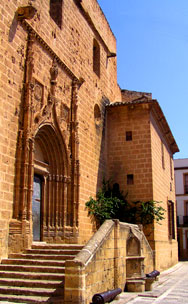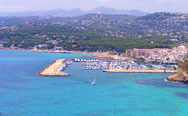- Villa search

- Canaries
- Caribbean
- Croatia, Bulgaria and Hungary
- Cyprus
- Florida
- France and Corsica
- Greece
- Italy
- Lakes and Mountains
- Madeira
- Malta and Gozo
- Portugal
- South Africa
- Spain - Balearics
A recent first for me was eating in a Romanian restaurant in Calpe. Other possibilities we could have gone for that night included Lebanese, Japanese, Belgian and Swiss restaurants, as well as Italian, Indian, Thai and Chinese (not to mention all-day breakfasts and other highlights of true-Brit gastronomy).

The church in Javea�s old centre is still pock-marked from Civil War fighting
The white limestone hills and cliffs that give the coast its name are also the source of the fine white sand that makes the area’s beaches some of the best in Spain.
‘You won’t find throbbing night-life and marauding teenagers in these family-friendly locations, much to the relief of most villa-renters’
There are plenty of hardy Costa Blanca residents who bathe in the sea every day of the year, but fair-weather swimmers will find the water very inviting from May to October (my most recent visit was in mid-April, when I swam most days: it was like Cornwall in August – fine once you got used to it!) One often-quoted claim is that the World Health Organisation has proclaimed the Costa Blanca to have the world’s healthiest climate, with 320 sunny days a year. Whether genuine or not, the claim certainly seems believable when you climb out of the plane into a warm, sunny day in December or February.
As you would expect, up and down the coast there’s every variety of water sport on offer, from dinghy sailing to kite-surfing. If that’s not enough to keep the family amused, there are plenty of other distractions, from go-karting to the massive Terra Mítica theme park near Benidorm.
If your tastes incline more towards the countryside, you will soon discover the other side to the Costa Blanca. Those limestone hills and cliffs pretty soon turn into mountains as you head inland.

Moraira marina, with beach behind
They provide fantastic walking country, with well-marked paths through fragrant scrub reminiscent of Corsica’s maquis. One example is a circular route in and through the Sierra de Bernia – literally through, because part of the path is a narrow, low natural tunnel pierced through the actual mountain ridge. It was on that path that I saw choughs for the first time – back home, these jackdaw-like birds with red beaks and feet are on the county crest of Cornwall, but are now found only in Wales.
Even if you don’t want to go walking, it’s well worthwhile exploring inland by car. Some of the villages are well-known – Guadalest is offered as an excursion to every package tourist on the coast – but others, like Castel de Castels, are out of reach of coaches and pleasant to wander around. On an inland drive, you’re guaranteed amazing views and beautiful countryside. And one nice aspect of this part of Spain is that you’re never far from a restaurant, often offering lunch on a shady terrace with stunning views.
Not that you necessarily need a car to enjoy the Costa Blanca. There’s a charming narrow-gauge railway that sways and rattles all the way from Alicante to Denia, with stations at all the main towns. It’s worthwhile as an experience in itself because it gives a quite different view of the countryside, away from the main roads, and can be quite exciting as it plunges through tunnels and over bridges. But it’s also worth taking the train into Alicante for a city awayday – it’s an impressive, vibrant city with an attractive waterfront and great shopping and restaurants.

Moraira
home | destinations and editorial | villa search | property for sale | car hire | flights | services
villaseek blog | contact villaseek | links and resources | advertise your villa© Dune Root Ltd and Villaseek.com 2012 - Caribbean
- Canaries